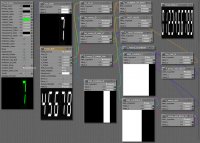3dcheapskate
Busy Bee
While trying to get a grip on the Du, Dv, dPdu, dPdv, dNdu and dNdv I created a very simplistic 'ten digit visualizer' in the Poser material room. The MT5 is posted on ShareCG here Ten Digit Visualizer (Poser MT5) - Poser - ShareCG if anybody wants to play.
In the comments on that ShareCG page English Bob pointed me at a thread where he, bagginsbill and some others had already created something similar in this "Animation in material files?" thread at Renderosity - www.renderosity.com/mod/forumpro/?thread_id=2852563
In the first page of that thread bagginsbill demonstrates how to display a single digit from an image containing all the digits 0 to 9, and shows several different display styles.
On the second page English Bob show show to use a number from another node (e.g. Frame_Number) as the input, and display a single digit from that number.
And they both obviously worked out how to display multiple digits - the end results were shown, but not the shader trees.
Since I was beginning to go crazy with Du, Dv, dPdu, dPdv, dNdu and dNdv I decided to try and work that out for myself...
(screenshot should appear in the next post)
In the comments on that ShareCG page English Bob pointed me at a thread where he, bagginsbill and some others had already created something similar in this "Animation in material files?" thread at Renderosity - www.renderosity.com/mod/forumpro/?thread_id=2852563
In the first page of that thread bagginsbill demonstrates how to display a single digit from an image containing all the digits 0 to 9, and shows several different display styles.
On the second page English Bob show show to use a number from another node (e.g. Frame_Number) as the input, and display a single digit from that number.
And they both obviously worked out how to display multiple digits - the end results were shown, but not the shader trees.
Since I was beginning to go crazy with Du, Dv, dPdu, dPdv, dNdu and dNdv I decided to try and work that out for myself...
(screenshot should appear in the next post)


